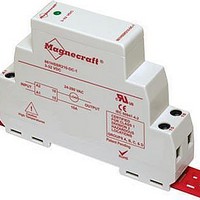861SSRA208-DC-2 Magnecraft / Schneider Electric, 861SSRA208-DC-2 Datasheet - Page 29

861SSRA208-DC-2
Manufacturer Part Number
861SSRA208-DC-2
Description
Modular Style
Manufacturer
Magnecraft / Schneider Electric
Datasheet
1.70S2-01-A-05-N.pdf
(32 pages)
Specifications of 861SSRA208-DC-2
Control Voltage Range
3 VDC to 32 VDC
Load Voltage Rating
24 VAC to 280 VAC
Load Current Rating
8 A
Contact Form
SPST - NO
Mounting Style
DIN Rail
Lead Free Status / RoHS Status
Lead free / RoHS Compliant
Lead Free Status / RoHS Status
Lead free / RoHS Compliant
Magnecraft
Solid State Relays
Application Data
®
(continued)
Transformers
In controlling transformers, consider the characteristics of the secondary load because
they reflect the effective load on the SSR� Voltage transients from secondary loads
circuits, similarly, are frequently transformers and can be imposed on the SSR�
Transformers present a special challenge in that, depending on the state of the
transformer flux at the time of turn off, the transformer may saturate during the first
half-cycle of subsequently applied voltage� This saturation can impose a very large
current (10 to 100 times rated typical) on the SSR which far exceeds its half cycle
surge rating� SSRs having random turn on may have a better chance of survival than
a zero cross turn on device for they commonly require the transformer to support only
a portion of the first half cycle of the voltage� On the other hand, a random turn on
device will frequently close at the zero cross point and then the SSR must sustain the
worst case saturation current� A zero cross turn on device has the advantage that it
turns on in a known mode and will immediately demonstrate the worst case condition�
The use of a current shunt and an oscilloscope is recommended to verify that the half
cycle surge capability is not exceeded�
A rule of thumb in applying an SSR to a transformer load is to select an SSR having
a half cycle current surge rating greater than the maximum applied line voltage
divided by the transformer primary resistance� The primary resistance is usually easily
measured and can be relied on as a minimum impedance limiting the first half cycle of
inrush current� The presence of some residual flux plus the saturated reactance of the
primary will then further limit, in the worst case, the half cycle surge safely within the
surge rating of the SSR�
Switching Devices
The power family of semiconductors consists of several switching devices� The
most widely used of this family are metal-oxide semiconductor field effect transistors
(MOSFETs), silicon controlled rectifiers (SCRs), Triac, and Alternistor Triac� In many
applications these devices perform key functions and therefore it is imperative that one
understand their advantages as well as their shortcomings to properly design a reliable
system� Once applied correctly SSRs are an asset in meeting environmental, speed,
and reliability specifications which their electromechanical counterparts could not fulfill�
• MOSFET
A power MOSFET is a specific type of metal oxide semiconductor field-effect transistor
(MOSFET) designed to handle large amounts of power� It is a vertical structured
transistor capable of sustaining high blocking voltage and high current� Power
MOSFET’s are used in DC switching applications� Care must be taken to ensure that
there is proper polarity for all DC ports� Failure to do so can lead to permanent device
damage�
• Triac
A TRIAC, is an electronic component approximately equivalent to two silicon-controlled
rectifiers joined in inverse parallel (paralleled but with the polarity reversed) and with
their gates connected together� This results in a bidirectional electronic switch which
can conduct AC current only� The Triac is ideal for switching non-reactive loads�
• Alternistor Triac
The Alternistor has been specifically designed for applications that switch highly
inductive AC loads� A special chip offers similar performance as two SCRs wired
inverse parallel (back-to-back), providing better turn-off behavior than a standard Triac�
The Alternistor Triac is an economical solution; ideal for switching inductive AC loads�
• SCR
The SCR (silicon-controlled rectifier) acts as a switch, conducting when its gate
receives a current pulse, and continue to conduct for as long as it is forward biased�
The SCR is ideal for switching all types of AC loads�
29
















